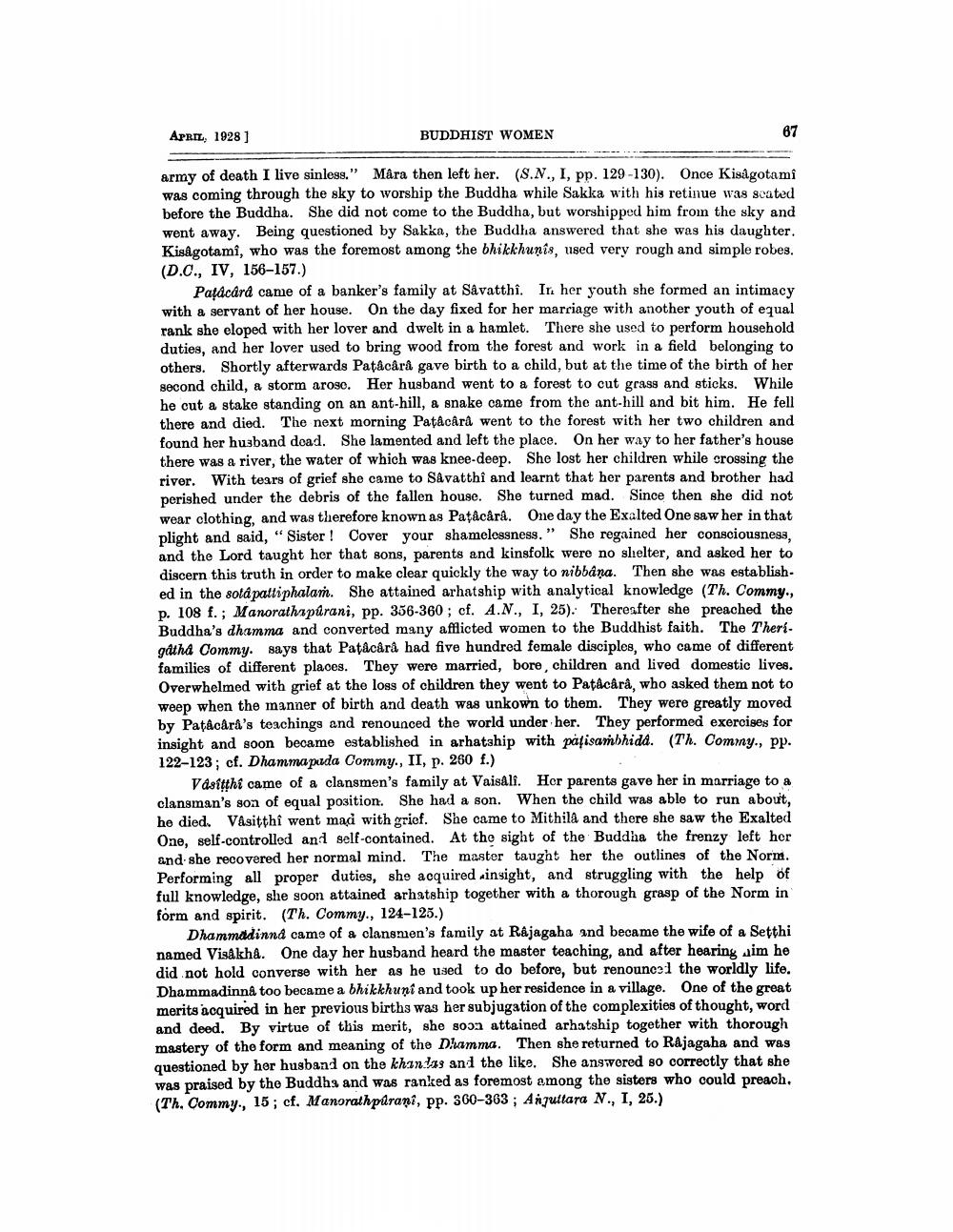________________
APRIL, 1928)
BUDDHIST WOMEN
67
army of death I live sinless." Mara then left her. (S.N., I, pp. 129-130). Once Kiságotami was coming through the sky to worship the Buddha while Sakka with his retinue was seated before the Buddha. She did not come to the Buddha, but worshipped him from the sky and went away. Being questioned by Sakka, the Buddha answered that she was his daughter. Kiságotami, who was the foremost among the bhikkhunis, used very rough and simple robes. (D.O., IV, 156-157.)
Pațácard came of a banker's family at Såvatthî. In her youth she formed an intimacy with a servant of her house. On the day fixed for her marriage with another youth of equal rank she eloped with her lover and dwelt in a hamlet. There she used to perform household duties, and her lover used to bring wood from the forest and work in a field belonging to others. Shortly afterwards Patåcårå gave birth to a child, but at the time of the birth of her second child, a storm aroso. Her husband went to a forest to cut grass and sticks. While he cut a stake standing on an ant-hill, a snake came from the ant-hill and bit him. He fell there and died. The next morning Patåcårå went to the forest with her two children and found her husband doad. She lamented and left the place. On her way to her father's house there was a river, the water of which was knee-deep. She lost her children while crossing the river. With tears of grief she came to Savatthî and learnt that her parents and brother had perished under the debris of the fallen house. She turned mad. Since then she did not wear clothing, and was therefore known as Patåcårå. One day the Exalted One saw her in that plight and said, “Sister ! Cover your shamelessness.” She regained her consciousness. and the Lord taught her that sons, parents and kinsfolk were no shelter, and asked her to discern this truth in order to make clear quickly the way to nibbana. Then she was established in the sotápattiphalar. She attained arhatship with analytical knowledge (Th. Commy.. p. 108 f.; Manorathapurani, pp. 356-360; cf. A.N., I, 25). Thereafter she preached the Buddha's dhamma and converted many afflicted women to the Buddhist faith. The Therigatha Commy. says that Patåcårå had five hundred female disciples, who came of different families of different places. They were married, bore, children and lived domestic lives. Overwhelmed with grief at the loss of children they went to Patåcårå, who asked them not to weep when the manner of birth and death was unkown to them. They were greatly moved by Patåcårå's teachings and renounced the world under her. They performed exercises for insight and soon became established in arhatahip with pafisambhidd. (Th. Commy., pp. 122-123; cf. Dhammapuda Commy., II, p. 260 f.)
Vasitthí came of a clansmen's family at Vaisali. Her parents gave her in marriage to a clansman's son of equal position. She had a son. When the child was able to run about, he died. Vasitthi went mad with grief. She came to Mithila and there she saw the Exalted One, self-controlled and self-contained. At the sight of the Buddha the frenzy left her and she recovered her normal mind. The master taught her the outlines of the Norm. Performing all proper duties, she acquired insight, and struggling with the help of full knowledge, she goon attained arhatship together with a thorough grasp of the Norm in form and spirit. (Th. Commy., 124-125.)
Dhammadinnd came of a clansmen's family at Rajagaha and became the wife of a Setthi named Visakha. One day her husband heard the master teaching, and after hearing uim he did not hold converse with her as he used to do before, but renounce1 the worldly life. Dhammadinna too became a bhikkhuni and took up her residence in a village. One of the great merits acquired in her previous births was her subjugation of the complexities of thought, word and deed. By virtue of this merit, she soon attained arhatship together with thorough mastery of the form and meaning of the Dramma. Then she returned to Rajagaha and was questioned by her husband on the khan las and the like. She answored so correctly that she was praised by the Buddhs and was ranked as foremost among the sisters who could preach. (Th. Commy., 15; cf. Manorathpurani, pp. 360-363 ; Angultara N., I, 25.)




